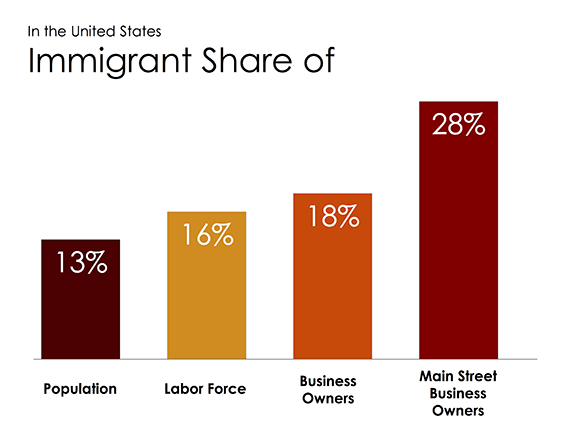Receiving communities can be geographic areas such as neighborhoods, or economic, social, or civic institutions such as employers, schools, or government agencies. When cities and communities around the country are able to harness the skills, experience, and energy that immigrants bring with them, the newcomers and the entire community experience the benefits.
Immigrant integration is a process. The new arrivals actively adjust to their new homes by learning the language, culture, and customs of the native population. Also, the pre-established community actively incorporates the new arrivals into the economic, social, and civic life of the region. This exchange transforms both the new arrivals and the native population. Often, that change comes with significant challenges, tension, and even conflict. Successful immigrant integration mitigates those challenges through education and engagement. Over the past 20 years, our world has become both hyperlocalized and hyperglobalized. Regions now compete to attract talent from abroad to fill gaps in their labor markets while opening doors of opportunity to new global markets.
Immigration Trends
In an opening presentation, David Dyssegaard Kallick, senior research fellow at the Fiscal Policy Institute (FPI), shared his findings after analyzing trends of population change and regional economic impact in cities across the country with declining populations between 1960 and 1980. Population decline eroded the tax base that had supported housing and infrastructure expansion over the previous decades. Vacant properties and blight followed, fueling further decline. St. Louis, Cleveland, Buffalo, and Pittsburgh experienced population declines of as much as 40 percent. Of the 50 largest cities in the country, 29 saw similar declines in population. Of these 29 cities, 14 rebounded with an increase in population between 1980 and 2013. The growth was attributable to the arrival of immigrants (individuals born in countries other than the U.S.). Kallick said that the cities that rebounded all had an increase in immigrant population. “This doesn’t prove that immigrants cause growth,” he said. “It may also be that immigrants are drawn to growth.”
Across the U.S., immigrants make up 13 percent of the population, 16 percent of the labor force, 18 percent of all business owners, and 28 percent of “Main Street” business owners, according to an FPI analysis (Figure 1).2 Kallick’s analysis found that immigrants own 58 percent of dry cleaners, 53 percent of grocery stores, 38 percent of restaurants, and 32 percent of clothing stores. In 31 of the 50 largest metro areas in the U.S., all net growth in the number of Main Street business owners was due to immigrants, Kallick said.
Figure 1. Twenty-eight percent of Main Street business owners are immigrants. Adapted from “Bringing Vitality to Main Street: How Immigrant Small Businesses Help Local Economies Grow,” Fiscal Policy Institute, January 2015; available at www.as-coa.org/sites/default/files/ImmigrantBusinessReport.pdf. Used with permission.

The ability to communicate well and access to capital are two critical components of achieving economic success in America. Accelerating language skills and gaining access to economic opportunities drive successful integration for immigrants. And for most immigrants, having a good job is key.
Entrepreneurial Development
Another panelist, Eva Hassett, executive director of the International Institute of Buffalo, stated that immigrants start businesses at twice the rate of native-born Americans.3
One way to help with the launch of these new businesses is through incubators. For example, in Nashville, Conexion Americas, a nonprofit organization, started a 10-week entrepreneurship course for Latino immigrants and established a modern commercial kitchen incubator where 25 immigrants from different countries operate their businesses, leading to cross-cultural collaboration.
Panelist José González, cofounder of Conexion Americas and an instructor in entrepreneurship at Belmont University, said that the incubator is located in Casa Azafrán, a community center that brings together 10 agencies that offer services in education, legal assistance, health care, and the arts to immigrants, refugees, and the community as a whole.
Welcoming Economies
Regional economic development initiatives can play a role not just in attracting immigrants, but also in retaining them and in enhancing their part in the community’s economic and social fabric, said Hassett. Over the last half-decade, a movement of local immigrant-welcoming and immigrant-focused economic development initiatives has been created and is beginning to define the national conversation around immigration. These initiatives are rooted in the fact that immigrant communities expand economic opportunities and revitalize regions. The Rust Belt region and other cities that have experienced a loss of a manufacturing base, for example, are well positioned to reinvigorate their communities by welcoming immigrants.
In the past three years, dozens of cities and states across the U.S. have launched efforts to attract and retain new residents, often focusing specifically on immigrants. These initiatives include Welcome Dayton, the St. Louis Mosaic Project, Global Detroit, the Michigan Office for New Americans, the New York State Office for New Americans, and Philadelphia’s Office of Immigrant Affairs, to name just a few. The panelists agreed that mayors are very important in setting the tone about the positive contribution that immigrants can make in their cities.
These efforts vary in specifics, but the overall focus is the same: to address issues of depopulation, demographic aging, and economic decline by inviting immigrants, including younger residents who have skills and can contribute to a region’s economic development, to become part of the local community and providing language and cultural support. While some initiatives are specifically focused on entrepreneurs or professional-class workers, others have explicitly invited a wider array of newcomers at every skill level.
Successful immigrant integration is a key element of the growth of the Philadelphia region and it helps build a more diverse, inclusive, and equitable society. Infusing new talent and ideas reinvigorates our workplaces, commercial centers, and communities. After nearly 60 years of population decline, Philadelphia experienced a modest increase in foreign-born residents, prompting the Brookings Institution to call Philadelphia a “re-emerging gateway city for immigrants.”4 The City of Philadelphia, under former Mayor Michael Nutter and now under Mayor Jim Kenney, has been strategic and purposeful in its approach to immigrant integration. By investing in language access programs that help make government services more accessible to newcomers and promoting immigrant entrepreneurship and workforce development programs through community-based organizations, Philadelphia is now competing to become the most welcoming city in America.
The views expressed here do not necessarily represent the views of the Federal Reserve Bank of Philadelphia or the Federal Reserve System.
[1]Peter Gonzales moderated the Reinventing Our Communities session on Immigrant Integration as an Economic Development Strategy.
[2]See “Bringing Vitality to Main Street: How Immigrant Small Businesses Help Local Economies Grow,” Fiscal Policy Institute, January 2015; available at www.as-coa.org/sites/default/files/ImmigrantBusinessReport.pdf. This report is an analysis of Americas Society/Council of the Americas 2013 five-year data.
[3]See “Open for Business: How Immigrants Are Driving Small Business Creation in the United States,” Report, The Partnership for a New American Economy, August 2012; available at www.renewoureconomy.org/research/open-for-business-how-immigrants-are-driving-small-business-creation-in-the-united-states-2/.
[4]See Audrey Singer, Domenic Vitiello, Michael Katz, and David Park, “Recent Immigration to Philadelphia: Regional Change in a Re-Emerging Gateway,” Metropolitan Policy Program Report, Brookings Institution, 2008; available at www.brookings.edu/wp-content/uploads/2016/06/1113_immigration_singer.pdf.

